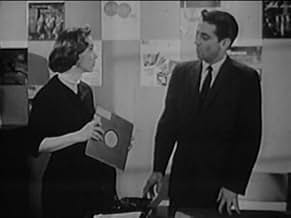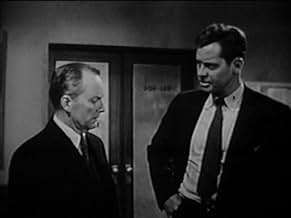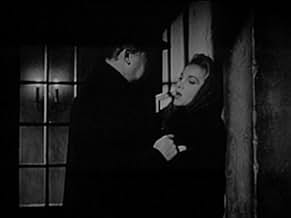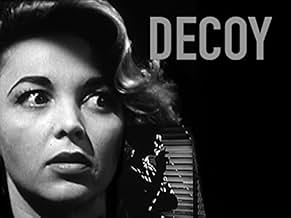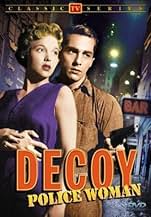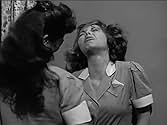Ajouter une intrigue dans votre langueNew York City policewoman Casey Jones' assignment to fight crime often entails her going undercover in some of the seediest and most dangerous parts of the city.New York City policewoman Casey Jones' assignment to fight crime often entails her going undercover in some of the seediest and most dangerous parts of the city.New York City policewoman Casey Jones' assignment to fight crime often entails her going undercover in some of the seediest and most dangerous parts of the city.
Parcourir les épisodes
Avis à la une
One would call "Decoy" for what it is... a female "Dragnet", with the beguiling Beverly Garland ("My Three Sons", "Scarecrow and Mrs. King") and the city of New York filling in for Jack Webb and sunny Los Angeles. But once you get caught in its premise, it's easy to overlook other aspects of the show. Such as the fact that Ms. Garland is required, in her role as undercover policewoman Patricia "Casey" Jones, to play a different role in each of the 39 episodes filmed. In one episode, she could play an exotic dancer in a carnival, in the next, she can play an addict, and so on and so on, all in the guise of a crime fighter. Whether Angie Dickinson, as Pepper Anderson - "Police Woman", took her cues from Beverly Garland is open to debate, but it's clear to say that Ms. Garland's Casey Jones is clearly a trailblazer for other lady lawmen to follow.
As for the other co-star, New York City... "Decoy" isn't the first series filmed on location in the Big Apple, nor was it the last, but it was certainly one of the most effective in terms of its film noir look and fully fleshed characters. This isn't "Naked City", but it's as close a similarity as you can get on a shoestring budget. And it does the city justice, as "Naked City" would do the next year. Check it out on DVD when you get the chance.
"Decoy" is a Pyramid Production in association with Official Films, Inc. with technical assistance from the Policewoman's Bureau, NYC Police Department. 39 episodes were filmed on location in 1957.
As for the other co-star, New York City... "Decoy" isn't the first series filmed on location in the Big Apple, nor was it the last, but it was certainly one of the most effective in terms of its film noir look and fully fleshed characters. This isn't "Naked City", but it's as close a similarity as you can get on a shoestring budget. And it does the city justice, as "Naked City" would do the next year. Check it out on DVD when you get the chance.
"Decoy" is a Pyramid Production in association with Official Films, Inc. with technical assistance from the Policewoman's Bureau, NYC Police Department. 39 episodes were filmed on location in 1957.
Most lead characters on TV cop shows in the 1950s and 60s were guys. Decoy was a departure from the usual fare by casting Beverly Garland as Policewoman Casey Jones. Amazon Prime currently has all episodes available.
"Decoy," a title fitting perfectly with Casey's assignments, would have benefited with the more marketable name "Policewoman." Surprisingly the classictvhistory.wordpress blog only mentions Decoy once in an article about Brenner, another late-50s Manhattan-based crime show. It deserves a detailed analysis.
What I first noticed about Decoy is the performance by the great Beverly Garland and her sympathetic yet no-nonsense, duty-bound and calm characterization. There is no humor whatsoever in Decoy, not even fatalistic police humor or the sardonic closing line of a conversation that Jack Webb practically patented in Dragnet. In her narration, she accepts her job with a sense of pessimism about the worst qualities of human nature that she knows will continue to repeat. What real policemen and policewomen see and deal with everyday would break the average person.
Then there's the world Casey lives in, when police science technology was still fairly crude and a lack of knowledge by the TV writers about the physical reality of criminal acts, something that continues in today's TV and films. She relies on her intuition and her ability to influence criminals to accept her so she can find the evidence or get the confession that allows her to slap the cuffs on them. There's very little gun play and shootouts, no insane car chases or gun glorification that's filled TV screens for decades and there's not much physical violence, something that Angie Dickinson's Policewoman would make up for in the more permissive 1970s, adding sexual themes and an emphasis on Dickinson's sex appeal to the mix.
The black and white location shooting of New York City and outer boroughs, when the city was heading to a decline adds a huge downbeat, melancholy tone. The dirty streets, sense of decay and crumbling tenements that Naked City also captured (and Hawk did in color in the 60s) creates a moody, grim feel to Casey's thankless job. The threadbare, shabby studio sets, a standard in 50s TV, reinforces that atmosphere. The brief, opening theme music to Decoy is stock, used in several earlier movies, and creates a sense of impending doom that sets the pace.
Casey solves her cases with a sense of fatalism, knowing that solving a case doesn't close the book on the tragedy in the wake of a crime. Families are destroyed, reputations are tarnished.
Later on, Beverly Garland opened the Beverly Garland hotel in Studio City. I occasionally attended movie collectible shows at the hotel but never had the chance to meet her and get an autograph. Now called The Garland as of 2014, it was built by her second husband.
"Decoy," a title fitting perfectly with Casey's assignments, would have benefited with the more marketable name "Policewoman." Surprisingly the classictvhistory.wordpress blog only mentions Decoy once in an article about Brenner, another late-50s Manhattan-based crime show. It deserves a detailed analysis.
What I first noticed about Decoy is the performance by the great Beverly Garland and her sympathetic yet no-nonsense, duty-bound and calm characterization. There is no humor whatsoever in Decoy, not even fatalistic police humor or the sardonic closing line of a conversation that Jack Webb practically patented in Dragnet. In her narration, she accepts her job with a sense of pessimism about the worst qualities of human nature that she knows will continue to repeat. What real policemen and policewomen see and deal with everyday would break the average person.
Then there's the world Casey lives in, when police science technology was still fairly crude and a lack of knowledge by the TV writers about the physical reality of criminal acts, something that continues in today's TV and films. She relies on her intuition and her ability to influence criminals to accept her so she can find the evidence or get the confession that allows her to slap the cuffs on them. There's very little gun play and shootouts, no insane car chases or gun glorification that's filled TV screens for decades and there's not much physical violence, something that Angie Dickinson's Policewoman would make up for in the more permissive 1970s, adding sexual themes and an emphasis on Dickinson's sex appeal to the mix.
The black and white location shooting of New York City and outer boroughs, when the city was heading to a decline adds a huge downbeat, melancholy tone. The dirty streets, sense of decay and crumbling tenements that Naked City also captured (and Hawk did in color in the 60s) creates a moody, grim feel to Casey's thankless job. The threadbare, shabby studio sets, a standard in 50s TV, reinforces that atmosphere. The brief, opening theme music to Decoy is stock, used in several earlier movies, and creates a sense of impending doom that sets the pace.
Casey solves her cases with a sense of fatalism, knowing that solving a case doesn't close the book on the tragedy in the wake of a crime. Families are destroyed, reputations are tarnished.
Later on, Beverly Garland opened the Beverly Garland hotel in Studio City. I occasionally attended movie collectible shows at the hotel but never had the chance to meet her and get an autograph. Now called The Garland as of 2014, it was built by her second husband.
Decoy's the first TV police drama to star a woman and casting couldn't have done better than Garland. She's strong and appealing but hardly glamorous, and really good at not over-playing her part though the tension is often there. As Casey Jones she goes undercover in downscale NYC to crack cases. The on-location filming in the city's seediest precincts lends a lot of color plus perspective to even the mildest episodes. Nevertheless, I'll bet the Chamber of Commerce was none to happy about grubby sites not often shown. Anyway, we get perspectives on the Statue of Liberty, crowded city streets, and soaring towers that seemingly entrap her as she walks along. All add color and period interest to the storylines. Of course some episodes are better than others but all offer abundant compensations. I haven't seen every episode, but let me recommend The Red Clown as particularly riveting. A look at the cast lists shows no stars but an abundance of familiar A-grade supporting players, e.g. Simon Oakland, Barbara Barrie. I guess ratings weren't strong enough for a second season (1958). Likely, 50's audiences weren't ready for a female lead in a traditionally male genre. Then again, to my knowledge, Decoy's never been re-run or put into syndication; so to say it's obscure is a mild understatement. Too bad, because the series was clearly ahead of its time, while its abundant human interest has no time limit.
In passing-- I caught up with the complete series in a DVD collection titled "Decoy" from Film Chest Media. I'd recommend the collection because of the detailed notes about locations and historical aspects of the productions that the enclosed booklet provides. For those like me who've never been to NYC, it's something of an interesting tour guide.
In passing-- I caught up with the complete series in a DVD collection titled "Decoy" from Film Chest Media. I'd recommend the collection because of the detailed notes about locations and historical aspects of the productions that the enclosed booklet provides. For those like me who've never been to NYC, it's something of an interesting tour guide.
Watching this on Amazon Prime. It's a series I hadn't had the opportunity to view on television. Yes, it's dated and some police techniques might seem questionable by today's standards, but it's ahead of its time by focusing on a female police officer and female victims and criminals. Lots of terrific early performances by actors who became well known and respected.
Stumbled across this on YouTube and ended up watching all 39 episodes - some better than others , most kept interest and some very good indeed - I remember having seen Beverly Garland in guest roles in many other tv shows back in the day - Westerns etc - she was very good - had great expressive eyes that did get the acting - The NYC locales were good and her voice overs added to the intimacy of the scripts - The Amazing thing was the number of later very familiar stars and character actors that appeared in this small syndicated show - if look up show on Wiki it lists them, over 35 listed - Peter Falk , Suzanne Pleshette , Simon Oakley and Barbara Barrie and on and on - almost a time capsule for fans actually . All from back in the day.
Le saviez-vous
- AnecdotesThe first cop show with a female protagonist.
- Crédits fousOpening credits include the dedication: "Presented as a tribute to the BUREAU OF POLICEWOMEN Police Department City of New York."
Meilleurs choix
Connectez-vous pour évaluer et suivre la liste de favoris afin de recevoir des recommandations personnalisées
- How many seasons does Decoy have?Alimenté par Alexa
Détails
- Durée
- 30min
- Couleur
- Mixage
- Rapport de forme
- 1.33 : 1
Contribuer à cette page
Suggérer une modification ou ajouter du contenu manquant


